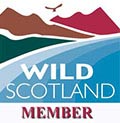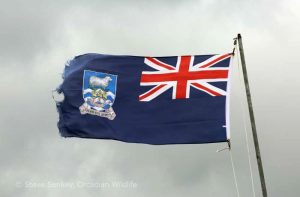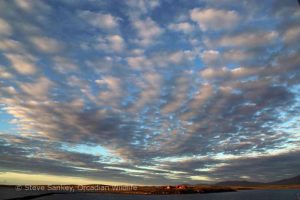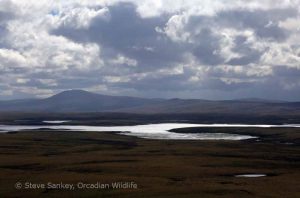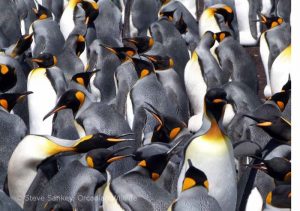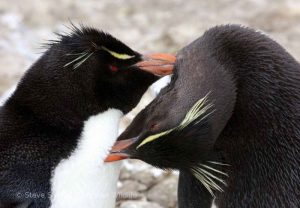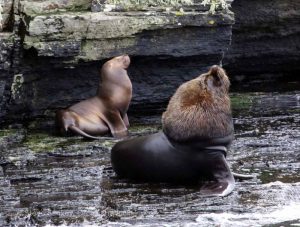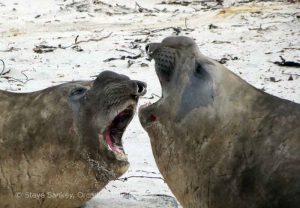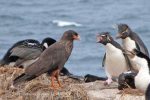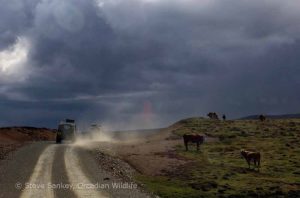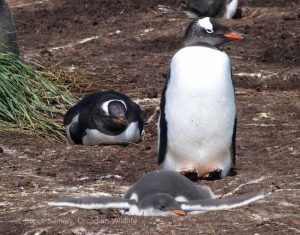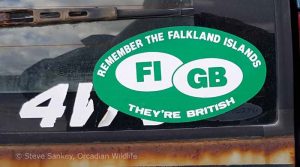24 January – 9 February 2024
The Falkland Islands is an archipelago of some 750 islands lying at 52°S in the South Atlantic, some 350 miles NE of Tierra del Fuego. With a population of around 3,000 it is a self-governing independent Overseas Territory of the UK. It is an island paradise, where the wildlife comes to you, and that’s why we visit! In some ways it is remarkably similar to Orkney: friendly locals, a windswept, treeless landscape, with great scenery and sea-scapes, big skies, and lots of wildlife.
You can expect to see five species of penguin (gentoo, Magellanic, king and rockhopper, with Macaroni as a bonus) with ease at extremely close quarters with six metres being the recommended distance. But in reality if you sit still, penguins will come much closer to you than that, so bring your wide-angle lens! Other birds that are unusual include the three endemic species – the Falklands cormorant, the Falklands steamer duck (called Loggers locally) and the Cobb’s wren, but there are an additional 11 sub-species of birds unique to the Falklands.
The Falkland Islands is responsible for much wildlife of global importance: over 70% of the world’s black-browed albatrosses; and the world’s largest populations of gentoo penguins (30%) and southern giant petrels (40%). It is also critically important for the conservation of striated caracara (called Johnny Rook locally), ruddy-headed geese, white-bridled finches and tussac birds, all of which are either seriously threatened or have very restricted distributions in South America. There are 175 native species of higher plants with 14 endemic species; and even wingless insects adapted to the windy environment and found nowhere else.
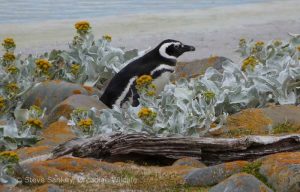
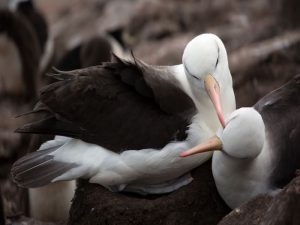 One reason we visit, however, is to watch and admire the sea mammals and cetaceans.
One reason we visit, however, is to watch and admire the sea mammals and cetaceans.
You are guaranteed safe but close views of both sea lions and elephant seals, and if you are lucky you may see both Commerson’s and Peale’s dolphins and even Sei whales and orcas. On Saunders Island and West Point Island (accessed from Carcass) you will also enjoyed close and breath-taking views of the magnificent black-browed albatrosses.
We visit a series of islands – six on this tour – and the capital and main town of Stanley. You will visit both East and West Falkland, and enjoy flying across the archipelago in small Islander aircraft (as used in Orkney) operated by FIGAS, the Falkland Island Government Air Service. Accommodation in ‘camp’ (the islanders’ term for the wider countryside, from the Spanish word ‘campo’) is simple but surprisingly comfortable. Our itineraries are put together by our partners at Falkland Island Holidays, with advice from Falklands Conservation. We use a combination of island guides plus myself to help you to get the most out of your visit to a unique destination. For our next tour (our 4th) we are visiting in late January and early February to see the young penguins and seals growing with their families and the wild flowers blooming in the diddledee – not to be missed!
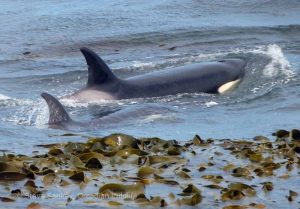 The next tour departs 24 January 2024. Group size is a maximum of 6 only. Cost £7,195 per person excluding flights. A single supplement of £595 will apply if applicable. One space may be available.
The next tour departs 24 January 2024. Group size is a maximum of 6 only. Cost £7,195 per person excluding flights. A single supplement of £595 will apply if applicable. One space may be available.
For further general information on the Falkland Islands see www.falklandislands.com
To find out more about the work of Falklands Conservation, to join, or even to adopt a penguin see www.falklandsconservation.com
Enquire here for a detailed itinerary or for an informal chat please phone Steve on 01856 831240.
14-25 January 2019 TOUR REPORT:
14 January 2019 – in transit from RAF Brize Norton to Mount Pleasant, FI by way of a re-fuelling stop in Cabo Verde. We agreed that the RAF Airbus 330 was a spacious and efficient means of getting there, with the bonus of endemic Lago sparrows hopping around Cabo Verde airport! An overnight sleep at Darwin Lodge on arrival, followed by a leisurely local walk around Colonel H Jones’ memorial in the morning was a perfect introduction to the common birds of the FI: Austral thrushes, crested ducks and ruddy-headed and upland geese. Long-tailed meadowlarks added some colour, and European brown hares were wonderful at close quarters. Our first FI endemic – the Falkland steamer duck (or ‘logger’) gave great views, with their groups of ducklings.
15-17 January – to the far NW for 3 nights at the self-catering cabin at the Neck, Saunders Island, as spectacular a place as I’ve ever seen! Our transfer flight in poor visibility low over the bogs and stone-runs of West Falkland, and including the spectacular chicane of the Warrah River was breathtaking. Huge cloud banks both sides of Elephant Point as we arrived added to the excitement. The nearby black-browed albatross; Imperial cormorants; and gentoo, king, Magellanic and rockhopper penguin colonies gave hours of entertainment. Commerson’s dolphins rode the surf offshore, and the usual predators of Falkland skuas, striated caracaras and turkey vultures caused mayhem in the colonies. A small but growing colony of c 20 king penguins is a star attraction.
18-20 January – back south again for 3 nights on Bleaker Island, a popular venue with all. Great accommodation, sheep shearing, and a large 8,000+ Imperial cormorant colony along with their sea lions, gentoos and rockhoppers gave us plenty to see. We spent a day out west at Cassard Point, seeing Peale’s dolphins, a pair of Southern caracaras with a newly fledged youngster, and several colonies of Southern giant petrels. On prominent display amidst the rockhoppers was a large and incongruous Macaroni, which completed our set of the 5 species of FI penguins!
21-22 January – further South still, to the ever-popular Sea Lion Island, with yes its sea lions, but also elephant seals and various penguin colonies. We had an evening foray to watch a family of short-eared owls, including a fledged youngster close above the Landrover, and the grey-backed storm petrels arriving ashore into the tussac grass. Early morning light at Elephant Corner was magical, with gathered Magellanic penguins braying and young male elephant seals strutting their stuff. The tussac and surrounds gave us our 2nd endemic – the Cobb’s wren – and also black-chinned siskin and white-bridled finch. Several white-chinned petrels offshore playing the gale along with albatrosses.
23-24 January – back to Stanley, the FI capital, where a full day was spent admiring the 2,000 pair strong colony of king penguins, having crossed the diddle-dee by 4WDs. En route we saw the unusual stone-runs of Mount Kent, and a strong showing of sooty shearwaters in Berkeley Sound.
Highlights:
- 55 species including 2 endemics: Falkland steamer duck and Cobb’s wren.
- European brown hares at close quarters at Darwin Lodge.
- All 5 penguin species: gentoo, king, Macaroni, Magellanic and rockhopper.
- Excellent close views of Commerson’s and Peale’s dolphins.
- Saunders, Bleaker and Sea Lion islands.
- The Neck at Saunders with its beaches, penguins and black-browed albatrosses.
- Bleaker’s 8,000 strong Imperial cormorant colony.
- Bleaker’s giant petrel colonies including a bait-station viewing at close quarters.
- Sea Lion’s young male elephant seals displaying at first light.
- Sea Lion’s crepuscular short-eared owls and grey-backed petrels.
- Volunteer Point’s 2,000 strong king penguin colony.
A fuller 2022 Tour report (24 October – 4 November 2022) is also available as a Word document – please contact Steve for a copy.

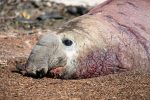
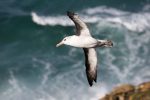
All pictures from 2022 tour, from left to right: rockhopper penguins with a raft of sooty shearwaters behind on Kidney Island; a blooded male elephant seal, Carcass Island; and a black-browed albatross fly-past on Saunders Island.

